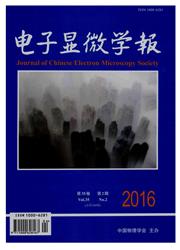

 中文摘要:
中文摘要:
本文报道了水热反应条件对BaTiO3纳米晶形成的影响,尤其是其原子尺度的表面结构。研究结果表明,Ba/Ti摩尔比较大的前驱体溶液中,易获得立方状大尺寸(~260nm)的BaTiO3纳米晶体;而采用乙二醇作为水热反应介质,可获得小尺寸弱圉聚的BaTiO3纳米晶(与纯水溶液或水-乙二醇的混合液相比较)。立方状或长方体状的BaTiO3纳米晶外表面被{100}晶面所包围,{110}晶面条纹与纳米晶体的边界相交呈45°角。在粗糙的BaTiO3纳米晶表面,常可观察到台面台阶扭折(terrace—ledge—kink)的表面结构,台面(terrace)和台阶(1edge)位于{100}晶面。由于表面结构的重构,{110}晶面通常被分解成由许多小的{100}晶面相连接而成的扭折结构。而在球状的BaTiO3纳米晶边缘,没有观察到表面台阶结构。
 英文摘要:
英文摘要:
The influences of reactive conditions upon the formation of BaTiO3 (BT) nanocrystals via hydrothermal process was investigated, especially on their atomic-scale surface microstructures. The results showed that large Ba/Ti molar ratios in the precursors could lead to large nanocrystals with a cubic morphology. Small nanocrystals with a weak agglomeration behavior were observed in the products synthesized via solvothermal process using ethylene glycol (EG) as reaction medium, in comparison to using either pure water or water-EG mixed solution as reactive medium. The BT nanocrystals with either cubic or rectangular shapes, are bounded by their {100} facets, as confirmed by the {110} lattice fringes intersecting with their edges at 45°. A terrace-ledge-kink (TLK) surface structure is frequently observed at the edges of the rough nanocrystals, and surface steps lying on the {100} planes are clearly observed. The {110} surfaces were found to be reconstructed and composed of the corners bound by the {100} mini-faces. However, in the spherical BT nanocrystals, no surface steps were observed at their edges.
 同期刊论文项目
同期刊论文项目
 同项目期刊论文
同项目期刊论文
 Single-Crystalline PbTiO3 Nanowires Synthesized by Microwave-Hydrothermal Process and Their Structur
Single-Crystalline PbTiO3 Nanowires Synthesized by Microwave-Hydrothermal Process and Their Structur Epitaxial BiFeO(3) Multiferroic Nanoislands Fabricated by Chemical Assembled Method and Their Charac
Epitaxial BiFeO(3) Multiferroic Nanoislands Fabricated by Chemical Assembled Method and Their Charac Microwave-hydrothermal synthesis and structural characterization of PX-phase single-crystalline PbTi
Microwave-hydrothermal synthesis and structural characterization of PX-phase single-crystalline PbTi 期刊信息
期刊信息
